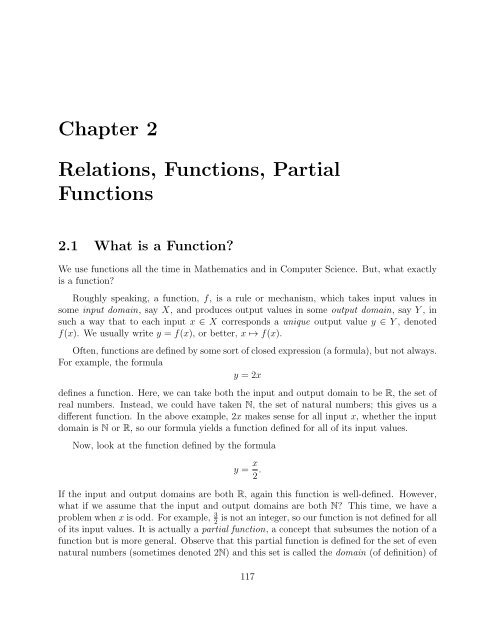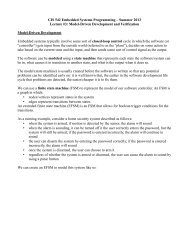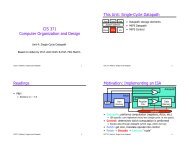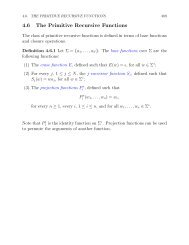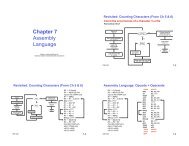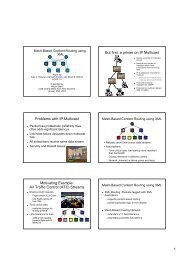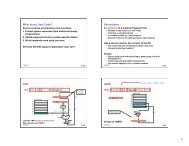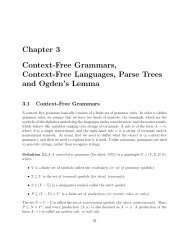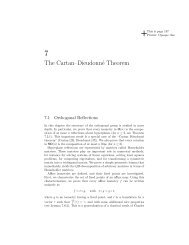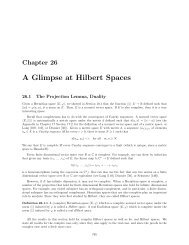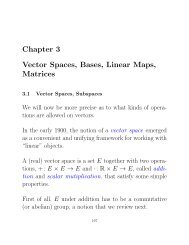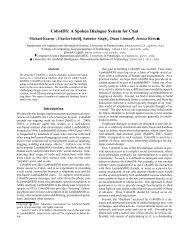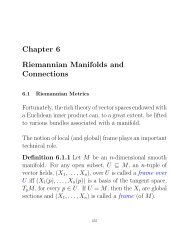Chapter 2 Relations, Functions, Partial Functions - Computer ...
Chapter 2 Relations, Functions, Partial Functions - Computer ...
Chapter 2 Relations, Functions, Partial Functions - Computer ...
Create successful ePaper yourself
Turn your PDF publications into a flip-book with our unique Google optimized e-Paper software.
126 CHAPTER 2. RELATIONS, FUNCTIONS, PARTIAL FUNCTIONS<br />
(1) P (0) holds and<br />
(2) For every n ∈ N, theimplicationP (n) ⇒ P (n +1)holds.<br />
As a formula, (1) and (2) can be written<br />
[P (0) ∧ (∀n ∈ N)(P (n) ⇒ P (n +1))]⇒ (∀n ∈ N)P (n).<br />
Step (1) is usually called the basis or base step of the induction and step (2) is called<br />
the induction step. In step (2), P (n) iscalledtheinduction hypothesis. That the above<br />
induction principle is valid is given by the<br />
Proposition 2.1 The Principle of Induction stated above is valid.<br />
Proof .Let<br />
S = {n ∈ N | P (n) =true}.<br />
By the induction principle (Version 2) stated at the send of Section 1.12, it is enough to<br />
prove that S is inductive, because then S = N and we are done.<br />
Since P (0) hold, we have 0 ∈ S. Now, if n ∈ S, i.e., if P (n) holds,sinceP (n) ⇒ P (n+1)<br />
holds for every n, wededucethatP (n+1) holds, that is, n+1 ∈ S. Therefore,S is inductive<br />
as claimed and this finishes the proof.<br />
Induction is a very valuable tool for proving properties of the natural numbers and we<br />
will make extensive use of it. We will also see other more powerful induction principles. Let<br />
us give some examples illustrating how it is used.<br />
We begin by finding a formula for the sum<br />
1+2+3+···+ n,<br />
where n ∈ N. Ifwecomputethissumforsmallvaluesofn, sayn =0, 1, 2, 3, 4, 5, 6weget<br />
What is the pattern?<br />
0 = 0<br />
1 = 1<br />
1+2 = 3<br />
1+2+3 = 6<br />
1+2+3+4 = 10<br />
1+2+3+4+5 = 15<br />
1+2+3+4+5+6 = 21.
2.3. INDUCTION PRINCIPLES ON N 127<br />
After a moment of reflection, we see that<br />
so we conjecture<br />
Claim 1 :<br />
where n ∈ N.<br />
0 = (0× 1)/2<br />
1 = (1× 2)/2<br />
3 = (2× 3)/2<br />
6 = (3× 4)/2<br />
10 = (4 × 5)/2<br />
15 = (5 × 6)/2<br />
21 = (6 × 7)/2,<br />
1+2+3+···+ n =<br />
n(n +1)<br />
,<br />
2<br />
For the basis of the induction, where n =0,weget0=0,sothebasestepholds.<br />
For the induction step, for any n ∈ N, assumethat<br />
1+2+3+···+ n =<br />
n(n +1)<br />
.<br />
2<br />
Consider 1 + 2 + 3 + ···+ n +(n +1). Then,usingtheinductionhypothesis,wehave<br />
1+2+3+···+ n +(n +1) =<br />
n(n +1)<br />
+ n +1<br />
2<br />
= n(n +1)+2(n +1)<br />
2<br />
= (n +1)(n +2)<br />
,<br />
2<br />
establishing the induction hypothesis and therefore, proving our formula.<br />
Next, let us find a formula for the sum of the first n +1oddnumbers:<br />
1+3+5+···+2n +1,<br />
where n ∈ N. Ifwecomputethissumforsmallvaluesofn, sayn =0, 1, 2, 3, 4, 5, 6weget<br />
1 = 1<br />
1+3 = 4<br />
1+3+5 = 9<br />
1+3+5+7 = 16<br />
1+3+5+7+9 = 25<br />
1+3+5+7+9+11 = 36<br />
1+3+5+7+9+11+13 = 49.
128 CHAPTER 2. RELATIONS, FUNCTIONS, PARTIAL FUNCTIONS<br />
This time, it is clear what the pattern is: we get perfect squares. Thus, we conjecture<br />
Claim 2 :<br />
where n ∈ N.<br />
1+3+5+···+2n +1=(n +1) 2 ,<br />
For the basis of the induction, where n =0,weget1=1 2 ,sothebasestepholds.<br />
For the induction step, for any n ∈ N, assumethat<br />
1+3+5+···+2n +1=(n +1) 2 .<br />
Consider 1 + 3 + 5 + ···+2n +1+2(n +1)+1=1+3+5+···+2n +1+2n +3. Then,<br />
using the induction hypothesis, we have<br />
1+3+5+···+2n +1+2n +3 = (n +1) 2 +2n +3<br />
= n 2 +2n +1+2n +3=n 2 +4n +4<br />
= (n +2) 2 .<br />
Therefore, the induction step holds and this completes the proof by induction.<br />
The two formulae that we just discussed are subject to a nice geometric interpetation<br />
that suggests a closed form expression for each sum and this is often the case for sums of<br />
special kinds of numbers. For the first formula, if we represent n as a sequence of n “bullets”,<br />
then we can form a rectangular array with n rows and n+1 columns showing that the desired<br />
sum is half of the number of bullets in the array, which is indeed n(n+1)<br />
,asshownbelowfor<br />
2<br />
n =5:<br />
• ◦ ◦ ◦ ◦ ◦<br />
• • ◦ ◦ ◦ ◦<br />
• • • ◦ ◦ ◦<br />
• • • • ◦ ◦<br />
• • • • • ◦<br />
Thus, we see that the numbers,<br />
n(n +1)<br />
∆n = ,<br />
2<br />
have a simple geometric interpretation in terms of triangles of bullets; for example, ∆4 =10<br />
is represented by the triangle<br />
•<br />
• •<br />
• • •<br />
• • • •<br />
For this reason, the numbers, ∆n, areoftencalledtriangular numbers. Anaturalquestion<br />
then arises: What is the sum<br />
∆1 +∆2 +∆3 + ···+∆n?
2.3. INDUCTION PRINCIPLES ON N 129<br />
The reader should compute these sums for small values of n and try to guess a formula that<br />
should then be proved correct by induction. It is not too hard to find a nice formula for<br />
these sums. The reader may also want to find a geometric interpretation for the above sums<br />
(stacks of cannon balls).<br />
In order to get a geometric interpretation for the sum<br />
1+3+5+···+2n +1,<br />
we represent 2n +1using2n +1bulletsdisplayedinaV -shape; for example, 7 = 2 × 3+1<br />
is represented by<br />
• •<br />
• •<br />
• •<br />
•<br />
Then, the sum 1 + 3 + 5 + ···+2n +1correspondstothesquare<br />
which clearly reveals that<br />
A natural question is then: What is the sum<br />
•<br />
• •<br />
• • •<br />
• • • •<br />
• • •<br />
• •<br />
•<br />
1+3+5+···+2n +1=(n +1) 2 .<br />
1 2 +2 2 +3 2 + ···+ n 2 ?<br />
Again, the reader should compute these sums for small values of n, thenguessaformula<br />
and check its correctness by induction. It is not too difficult to find such a formula. For a<br />
fascinating discussion of all sorts of numbers and their geometric interpretations (including<br />
the numbers we just introduced), the reader is urged to read <strong>Chapter</strong> 2 of Conway and Guy<br />
[10].<br />
Sometimes, it is necessary to prove a property, P (n), for all natural numbers n ≥ m,<br />
where m>0. Our induction principle does not seem to apply since the base case is not<br />
n = 0. However, we can define the property, Q(n), given by<br />
Q(n) =P (m + n), n ∈ N,<br />
,
130 CHAPTER 2. RELATIONS, FUNCTIONS, PARTIAL FUNCTIONS<br />
and since Q(n) holdsforalln ∈ N iff P (k) holdsforallk ≥ m, wecanapplyourinduction<br />
principle to prove Q(n) foralln ∈ N and thus, P (k), for all k ≥ m (note, k = m + n). Of<br />
course, this amounts to considering that the base case is n = m and this is what we always<br />
do without any further justification. Here is an example.<br />
Let us prove that<br />
The base case is n =10. Forn =10,weget<br />
(3n) 2 ≤ 2 n , for all n ≥ 10.<br />
(3 × 10) 2 =30 2 =900≤ 1024 = 2 10 ,<br />
which is indeed true. Let us now prove the induction step. Assuming that (3n) 2 ≤ 2 n holds<br />
for all n ≥ 10, we want to prove that (3(n +1)) 2 ≤ 2 n+1 .Since<br />
(3(n +1)) 2 =(3n +3) 2 =(3n) 2 +18n +9,<br />
if we can prove that 18n+9 ≤ (3n) 2 when n ≥ 10, using the induction hypothesis, (3n) 2 ≤ 2 n ,<br />
we will have<br />
(3(n +1)) 2 =(3n) 2 +18n +9≤ (3n) 2 +(3n) 2 ≤ 2 n +2 n =2 n+1 ,<br />
establishing the induction step. However,<br />
(3n) 2 − (18n +9)=(3n − 3) 2 − 18<br />
and (3n − 3) 2 ≥ 18 as soon as n ≥ 3, so 18n +9≤ (3n) 2 when n ≥ 10, as required.<br />
Observe that the formula (3n) 2 ≤ 2 n fails for n =9,since(3× 9) 2 =27 2 =729and<br />
2 9 =512,but729> 512. Thus, the base has to be n =10.<br />
There is another induction principle which is often more flexible that our original induction<br />
principle. This principle, called complete induction (or sometimes strong induction), is<br />
stated below.<br />
Complete Induction Principle for N.<br />
In order to prove that a predicate, P (n), holds for all n ∈ N it is enough to prove that<br />
(1) P (0) holds (the base case) and<br />
(2) for every m ∈ N, if(∀k ∈ N)(k ≤ m ⇒ P (k)) then P (m +1).<br />
The difference between ordinary induction and complete induction is that in complete<br />
induction, the induction hypothesis, (∀k ∈ N)(k ≤ m ⇒ P (k)), assumes that P (k) holds<br />
for all k ≤ m and not just for m (as in ordinary induction), in order to deduce P (m +1).<br />
This gives us more proving power as we have more knowledge in order to prove P (m +1).<br />
Complete induction will be discussed more extensively in Section 5.3 and its validity will be
132 CHAPTER 2. RELATIONS, FUNCTIONS, PARTIAL FUNCTIONS<br />
since 5<br />
9 > ,whichconcludestheproofoftheinductionstep. Observethatweusedthe<br />
2 4<br />
induction hypothesis for both Fn+1 and Fn in order to deduce that it holds for Fn+2. Thisis<br />
where we needed the extra power of complete induction.<br />
Remark: The Fibonacci sequence, Fn, isreallyafunctionfromN to N defined recursively<br />
but we haven’t proved yet that recursive definitions are legitimate methods for defining<br />
functions. In fact, certain restrictions are needed on the kind of recursion used to define<br />
functions. This topic will be explored further in Section 2.5. Using results from Section 2.5,<br />
it can be shown that the Fibonacci sequence is a well-defined function (but this does not<br />
follow immediately from Theorem 2.3).<br />
Induction proofs can be subtle and it might be instructive to see some examples of faulty<br />
induction proofs.<br />
Assertion 1: For every natural numbers, n ≥ 1, the number n 2 − n +11isanoddprime<br />
(recall that a prime number is a natural number, p ≥ 2, which is only divisible by 1 and<br />
itself).<br />
Proof .Weuseinductiononn ≥ 1. For the base case, n =1,wehave1 2 − 1+11=11,<br />
which is an odd prime, so the induction step holds.<br />
Assume inductively that n 2 − n +11isprime. Then,as<br />
we see that<br />
(n +1) 2 − (n +1)+11=n 2 +2n +1− n − 1+11=n 2 + n +11,<br />
(n +1) 2 − (n +1)+11=n 2 − n +11+2n.<br />
By the induction hypothesis, n 2 − n +11isanoddprime,p, andsince2n is even, p +2n is<br />
odd and therefore prime, establishing the induction hypothesis.<br />
If we compute n 2 − n +11forn =1, 2,...,10, we find that these numbers are indeed all<br />
prime, but for n =11,weget<br />
which is not prime.<br />
Where is the mistake?<br />
121 = 11 2 − 11 + 11 = 11 × 11,<br />
What is wrong is the induction step: the fact that n 2 − n +11isprimedoesnotimply<br />
that (n +1) 2 − (n +1)+11=n 2 + n +11isprime,asillustratedbyn =10. Our“proof”<br />
of the induction step is nonsense.<br />
The lesson is: The fact that a statement holds for many values of n ∈ N does not imply<br />
that it holds for all n ∈ N (or all n ≥ k, forsomefixedk ∈ N).<br />
Interestingly, the prime numbers, k, sothatn 2 −n+k is prime for n =1, 2,...,k−1, are<br />
all known (there are only six of them). It can be shown that these are the prime numbers,<br />
k, suchthat1− 4k is a Heegner number, where the Heegner numbers are the nine integers:<br />
−1, −2, −3, −7, −11, −19, −43, −67, −163.
2.5. RECURSION ON N 135<br />
of f with g, eventhoughitistheoppositeoftheconventionforwritingthecompositionof<br />
relations.<br />
Given any three relations, R ⊆ A × B, S ⊆ B × C and T ⊆ C × D, thereadershould<br />
verify that<br />
(R ◦ S) ◦ T = R ◦ (S ◦ T ).<br />
We say that composition is associative. Similarly,foranythreefunctions(possiblypartial),<br />
f : A → B, g : B → C and h: C → D, wehave(associativityoffunctioncomposition)<br />
2.5 Recursion on N<br />
(h ◦ g) ◦ f = h ◦ (g ◦ f).<br />
The following situation often occurs: We have some set, A, somefixedelement,a ∈ A, some<br />
function, g : A → A, andwewishtodefineanewfunction,h: N → A, sothat<br />
h(0) = a,<br />
h(n +1) = g(h(n)) for all n ∈ N.<br />
This way of defining h is called a recursive definition (or a definition by primitive recursion).<br />
I would be surprised if any computer scientist had any trouble with this “definition”<br />
of h but how can we justify rigorously that such a function exists and is unique?<br />
Indeed, the existence (and uniqueness) of h requires proof. The proof, although not really<br />
hard, is surprisingly involved and, in fact quite subtle. For those reasons, we will not give a<br />
proof of the following theorem but instead the main idea of the proof. The reader will find<br />
acompleteproofinEnderton[19](<strong>Chapter</strong>4).<br />
Theorem 2.3 (Recursion Theorem on N) Given any set, A, any fixed element, a ∈ A, and<br />
any function, g : A → A, there is a unique function, h: N → A, so that<br />
h(0) = a,<br />
h(n +1) = g(h(n)) for all n ∈ N.<br />
Proof .Theideaistoapproximateh. To do this, define a function, f, tobeacceptable iff<br />
1. dom(f) ⊆ N and range(f) ⊆ A;<br />
2. If 0 ∈ dom(f), then f(0) = a;<br />
3. If n +1∈ dom(f), then n ∈ dom(f) andf(n +1)=g(f(n)).
2.8. DIRECT IMAGE AND INVERSE IMAGE 145<br />
Remarks:<br />
1. The overloading of notation where f is used both for denoting the original function<br />
f : X → Y and the new function f :2 X → 2 Y may be slightly confusing. If we observe<br />
that f({x}) ={f(x)}, forallx ∈ X, weseethatthenewf is a natural extension<br />
of the old f to the subsets of X and so, using the same symbol f for both functions<br />
is quite natural after all. To avoid any confusion, some authors (including Enderton)<br />
use a different notation for f(A), for example, f [A]. We prefer not to introduce more<br />
notation and we hope that the context will make it clear which f we are dealing with.<br />
2. The use of the notation f −1 for the function f −1 :2 Y → 2 X may even be more confusing,<br />
because we know that f −1 is generally not a function from Y to X. However, it is a<br />
function from 2 Y to 2 X . Again, some authors use a different notation for f −1 (B), for<br />
example, f −1 [A]. We will stick to f −1 (B).<br />
3. The set f(A) is sometimes called the push-forward of A along f and f −1 (B) issometimes<br />
called the pullback of B along f.<br />
4. Observe that f −1 (y) = f −1 ({y}), where f −1 (y) isthepreimagedefinedjustafter<br />
Definition 2.3.<br />
5. Although this may seem counter-intuitive, the function f −1 has a better behavior than<br />
f with respect to union, intersection and complementation.<br />
Some useful properties of f :2 X → 2 Y and f −1 :2 Y → 2 X are now stated without proof.<br />
The proofs are easy and left as exercises.<br />
Proposition 2.6 Given any function, f : X → Y , the following properties hold:<br />
(1) For any B ⊆ Y , we have<br />
(2) If f : X → Y is surjective, then<br />
(3) For any A ⊆ X, we have<br />
(4) If f : X → Y is injective, then<br />
f(f −1 (B)) ⊆ B.<br />
f(f −1 (B)) = B.<br />
A ⊆ f −1 (f(A)).<br />
A = f −1 (f(A)).<br />
The next proposition deals with the behavior of f :2 X → 2 Y and f −1 :2 Y → 2 X with<br />
respect to union, intersection and complementation.
146 CHAPTER 2. RELATIONS, FUNCTIONS, PARTIAL FUNCTIONS<br />
Proposition 2.7 Given any function, f : X → Y , the following properties hold:<br />
(1) For all A, B ⊆ X, we have<br />
(2)<br />
(3)<br />
Equality holds if f : X → Y is injective.<br />
Equality holds if f : X → Y is injective.<br />
(4) For all C, D ⊆ Y , we have<br />
(5)<br />
(6)<br />
f(A ∪ B) =f(A) ∪ f(B).<br />
f(A ∩ B) ⊆ f(A) ∩ f(B).<br />
f(A) − f(B) ⊆ f(A − B).<br />
f −1 (C ∪ D) =f −1 (C) ∪ f −1 (D).<br />
f −1 (C ∩ D) =f −1 (C) ∩ f −1 (D).<br />
f −1 (C − D) =f −1 (C) − f −1 (D).<br />
As we can see from Proposition 2.7, the function f −1 :2 Y → 2 X has a better behavior<br />
than f :2 X → 2 Y with respect to union, intersection and complementation.<br />
2.9 Equinumerosity; The Pigeonhole Principle and the<br />
Schröder–Bernstein Theorem<br />
The notion of size of a set is fairly intuitive for finite sets but what does it mean for infinite<br />
sets? How do we give a precise meaning to the questions:<br />
(a) Do X and Y have the same size?<br />
(b) Does X have more elements than Y ?<br />
For finite sets, we can rely on the natural numbers. We count the elements in the two<br />
sets and compare the resulting numbers. If one of the two sets is finite and the other is<br />
infinite, it seems fair to say that the infinite set has more elements than the finite one.<br />
But what if both sets are infinite?
152 CHAPTER 2. RELATIONS, FUNCTIONS, PARTIAL FUNCTIONS<br />
Remark: The notion of cardinality also makes sense for infinite sets. What happens is that<br />
every set is equinumerous to a special kind of set (an initial ordinal) called a cardinal (or<br />
cardinal number). Let us simply mention that the cardinal number of N is denoted ℵ0 (say<br />
“aleph” 0). A naive way to define the cardinality of a set, X, wouldbetodefineitasthe<br />
equivalence class, {Y | Y ≈ X}, ofallsetsequinumeroustoX. However, this does not work<br />
because the collection of sets, Y , such that Y ≈ X, isnotaset! Inordertoavoidthislogical<br />
difficulty, one has to define the notion of a cardinal in a more subtle manner. One way to<br />
proceed is to first define ordinals, certainkindsofwell-orderedsets. Then,assumingthe<br />
axiom of choice, every set, X, isequinumeroustosomeordinalandthecardinal,|X|, ofthe<br />
set, X, isdefinedastheleastordinalequinumeroustoX (an initial ordinal). The theory<br />
of ordinals and cardinals is thoroughly developed in Enderton [19] and Suppes [59] but it is<br />
beyond the scope of this book.<br />
Corollary 2.12 (a) Any set equinumerous to a proper subset of itself is infinite.<br />
(b) The set N is infinite.<br />
Proof . Left as an exercise to the reader.<br />
The image of a finite set by a function is also a finite set. In order to prove this important<br />
property we need the next two propositions. The first of these two propositions may appear<br />
trivial but again, a rigorous proof requires induction.<br />
Proposition 2.13 Let n be any positive natural number, let A be any nonempty set and<br />
pick any element, a0 ∈ A. Then there exists a bijection, f : A → [n +1], iff there exists a<br />
bijection, g :(A −{a0}) → [n].<br />
Proof .Weproceedbyinductiononn ≥ 1. The proof of the induction step is very similar<br />
to the proof of the induction step in Proposition 2.10. The details of the proof are left as an<br />
exercise to the reader.<br />
Proposition 2.14 For any function, f : A → B, if f is surjective and if A is a finite<br />
nonempty set, then B is also a finite set and there is an injection, h: B → A, such that<br />
f ◦ h =idB. Moreover, |B| ≤|A|.<br />
Proof .Theexistenceofaninjection,h: B → A, suchthatf ◦ h =idB, followsimmediately<br />
from Theorem 2.5 (b), but the proof uses the Axiom of Choice, which seems a bit of an<br />
overkill. However, we can give an alternate proof avoiding the use of the Axiom of Choice<br />
by proceeding by induction on the cardinality of A.<br />
If A has a single element, say a, sincef is surjective, B is the one-element set (obviously<br />
finite), B = {f(a)}, andthefunction,h: B → A, givenbyg(f(a)) = a is obviously a<br />
bijection such that f ◦ h =idB.<br />
For the induction step, assume that A has n+1 elements. If f is a bijection, then h = f −1<br />
does the job and B is a finite set with n + 1 elements.
154 CHAPTER 2. RELATIONS, FUNCTIONS, PARTIAL FUNCTIONS<br />
The proof of Proposition 2.18 is left as an exercise (use Corollary 2.11 and Proposition<br />
2.14).<br />
Proposition 2.18 only holds for finite sets. Indeed,justaftertheremarksfollowingDefinition<br />
2.8 we gave examples of functions defined on an infinite set for which Proposition 2.18<br />
fails.<br />
Aconvenientcharacterizationofcountablesetsisstatedbelow:<br />
Proposition 2.19 A nonempty set, A, is countable iff there is a surjection, g : N → A,<br />
from N onto A.<br />
Proof .Recallthatbydefinition,A is countable iff there is an injection, f : A → N. The<br />
existence of a surjection, g : N → A follows from Theorem 2.5 (a). Conversely, if there is a<br />
surjection, g : N → A, then by Theorem 2.5 (b), there is an injection f : A → N. However,<br />
the proof of Theorem 2.5 (b) requires the axiom of choice. It is possible to avoid the axiom<br />
of choice by using the fact that every nonempty subset of N has a smallest element (see<br />
Theorem 5.6).<br />
The following fact about infinite sets is also useful to know:<br />
Theorem 2.20 For every infinite set, A, there is an injection from N into A.<br />
Proof .TheproofofTheorem2.20isactuallyquitetricky.Itrequiresaversionoftheaxiom<br />
of choice and a subtle use of the Recursion Theorem (Theorem 2.3). Let us give a sketch of<br />
the proof.<br />
The version of the axiom of choice that we need says that for every nonempty set, A, there<br />
is a function, F ,(achoice function) suchthatthedomainofF is 2 A − {∅} (all nonempty<br />
subsets of A) andsuchthatF (B) ∈ B for every nonempty subset, B, ofA.<br />
We use the Recursion Theorem to define a function, h, fromN to the set of finite subsets<br />
of A. Thefunction,h, isdefinedby<br />
h(0) = ∅<br />
h(n +1) = h(n) ∪{F (A − h(n))}.<br />
Because A is infinite and h(n) isfinite,A − h(n) isnonemptyandweuseF to pick some<br />
element in A − h(n), which we then add to the set, h(n), creating a new finite set, h(n +1).<br />
Now, we define, g : N → A, by<br />
g(n) =F (A − h(n))<br />
for all n ∈ N. Sinceh(n) isfiniteandA is infinite, g is well-defined. It remains to check that<br />
g is an injection. For this, we observe that g(n) /∈ h(n) sinceF (A − h(n)) ∈ A − h(n), the<br />
details are left as an exercise.<br />
The intuitive content of Theorem 2.20 is that N is the “smallest” infinite set.
2.9. EQUINUMEROSITY; PIGEONHOLE PRINCIPLE; SCHRÖDER–BERNSTEIN 155<br />
An immediate consequence of Theorem 2.20 is that every infinite subset of N is equinumerous<br />
to N.<br />
Here is a characterization of infinite sets originally proposed by Dedekind in 1888.<br />
Proposition 2.21 A set, A, is infinite iff it is equinumerous to a proper subset of itself.<br />
Proof .IfA is equinumerous to a proper subset of itself, then it must be infinite since<br />
othwerwise the Pigeonhole Principle would be contradicted.<br />
Conversely, assume A is infinite. By Theorem 2.20, there is an injection, f : N → A.<br />
Define the function, g : A → A, asfollows:<br />
g(f(n)) = f(n +1) if n ∈ N<br />
g(a) = a if a/∈ Im (f).<br />
It is easy to check that g is a bijection of A onto A −{f(0)}, apropersubsetofA.<br />
Let us give another application of the pigeonhole principle involving sequences of integers.<br />
Given a finite sequence, S, ofintegers,a1,...,an, asubsequence of S is a sequence, b1,...,bm,<br />
obtained by deleting elements from the original sequence and keeping the remaining elements<br />
in the same order as they originally appeared. More precisely, b1,...,bm is a subsequence<br />
of a1,...,an if there is an injection, g : {1,...,m}→{1,...,n}, suchthatbi = ag(i) for all<br />
i ∈{1,...,m} and i ≤ j implies g(i) ≤ g(j) foralli, j ∈{1,...,m}. For example, the<br />
sequence<br />
1 9 10 8 3 7 5 2 6 4<br />
contains the subsequence<br />
9 8 6 4.<br />
An increasing subsequence is a subsequence whose elements are in strictly increasing order<br />
and a decreasing subsequence is a subsequence whose elements are in strictly decreasing<br />
order. For example, 9 8 6 4 is a decreasing subsequence of our original sequence. We now<br />
prove the following beautiful result due to Erdös and Szekeres:<br />
Theorem 2.22 (Erdös and Szekeres) Let n be any nonzero natural number. Every sequence<br />
of n 2 +1 pairwise distinct natural numbers must contain either an increasing subsequence or<br />
a decreasing subsequence of length n +1.<br />
Proof .Theproofproceedsbycontradiction.So,assumethereisasequence,S, ofn 2 +1<br />
pairwise distinct natural numbers so that all increasing or decreasing subsequences of S<br />
have length at most n. Weassigntoeveryelement,s, ofthesequence,S, apairofnatural<br />
numbers, (us,ds), called a label, whereus, isthelengthofalongestincreasingsubsequence<br />
of S that starts at s and where ds is the length of a longest decreasing subsequence of S that<br />
starts at s.
2.10. AN AMAZING SURJECTION: HILBERT’S SPACE FILLING CURVE 159<br />
Figure 2.16: A sequence of Hilbert curves h0,h1,h2<br />
The curve hn+1 is obtained by scaling down hn by a factor of 1<br />
2 ,andconnectingthe<br />
four copies of this scaled–down version of hn obtained by rotating by π/2 (leftlowerpart),<br />
rotating by −π/2 and translating right (right lower part), translating up (left upper part),<br />
and translating diagonally (right upper part), as illustrated in Figure 2.16.<br />
Figure 2.17: The Hilbert curve h5<br />
It can be shown that the sequence (hn) converges (uniformly) to a continuous curve<br />
h: [0, 1] → [0, 1] × [0, 1] whose trace is the entire square [0, 1] × [0, 1]. The Hilbert curve h is<br />
surjective, continuous, and nowhere differentiable. It also has infinite length.<br />
The curve h5 is shown in Figure 2.17. You should try writing a computer program to<br />
plot these curves. By the way, it can be shown that no continuous square-filling function<br />
can be injective. It is also possible to define cube-filling curves and even higher-dimensional<br />
cube-filling curves.
2.12. SUMMARY 165<br />
• We define the first and second projection of a pair<br />
• We define binary relations and their domain and range<br />
• We define the identity relation<br />
• We define functional relations<br />
• We define partial functions, total functions, thegraph of a partial or total function,<br />
the domain and the range of a (partial) function<br />
• We define the preimage or inverse image, f −1 (a), of an element a by a (partial) function<br />
f<br />
• The set of all functions from A to B is denoted B A<br />
• We revisit the induction principle for N stated in terms of properties and give several<br />
examples of proofs by induction<br />
• We state the complete induction principle for N and prove its validity; we prove a<br />
property of the Fibonacci numbers by complete induction<br />
• We define the composition, R ◦ S, of two relations R and S<br />
• We prove some basic properties of the composition of functional relations<br />
• We define the composition, g ◦ f, oftwo(partialortotal)functions,f and g<br />
• We describe the process of defining functions on N by recursion and state a basic result<br />
about the validity of such a process (The recursion Theorem on N)<br />
• We define the left inverse and the right inverse of a function<br />
• We define invertible functions and prove the uniqueness of the inverse, f −1 ,ofafunction,<br />
f, whenitexists<br />
• We define the inverse or converse of a relation<br />
• We define, injective, surjective and bijective functions<br />
• We characterize injectivity, surjectivity and bijectivity in terms of left and right inverses<br />
• We observe that to prove that a surjective function has a right inverse, we need the<br />
Axiom of Choice (AC)<br />
• We define sections, retractions, andtherestriction of a function to a subset of its<br />
domain<br />
• We define direct and inverse images of a set under a function (f(A), resp. f −1 (B))
166 CHAPTER 2. RELATIONS, FUNCTIONS, PARTIAL FUNCTIONS<br />
• We prove some basic properties of direct and inverse images with respect to union,<br />
intersection and relative complement<br />
• We define when two sets are equinumerous or when a set A dominates asetB<br />
• We give a bijection between N × N and N<br />
• We define when a set if finite or infinite<br />
• We prove that N is not equinumerous to R (the real numbers), a result due to Cantor,<br />
and that there is no surjection from A to 2 A<br />
• We define the characteristic function, χA, ofasubset,A<br />
• We state and prove the pigeonhole principle<br />
• The set of natural numbers, N, isinfinite<br />
• Every finite set, A, is equinumerous with a unique set, [n] ={1,...,n}, andtheinteger,<br />
n, iscalledthecardinality of A and is denoted |A|<br />
• If A is a finite set, then for every function, f : A → B, theimage,f(A), of f is finite<br />
and |f(A)| ≤|A|<br />
• Any subset, A, ofafiniteset,B, isalsofiniteand|A| ≤|B|<br />
• If A is a finite set, then every injection, f : A → A, is a bijection and every surjection,<br />
f : A → A, isabijection<br />
• Aset,A, iscountableiffthereisasurjectionfromN onto A<br />
• For every infinite set, A, thereisaninjectionfromN into A<br />
• Aset,A, isinfiniteiffitisequinumeroustoapropersubsetofitself<br />
• We state the Schröder-Bernstein Theorem<br />
• We state that every infinite set, A, isequinumeroustoA × A<br />
• We state the cardinal comparability theorem<br />
• We mention Zorn’s lemma, one of the many versions of the Axiom of Choice<br />
• We describe Hilbert’s space filling curve<br />
• We define strings and multisets<br />
• We define the product of a family of sets and explain how the non-emptyness of such<br />
a product is equivalent to the Axiom of Choice
2.13. PROBLEMS 173<br />
Problem 2.22 Consider the sum<br />
with n ≥ 1.<br />
3 5<br />
2n +1<br />
+ + ···+<br />
1 · 4 4 · 9 n2 ,<br />
· (n +1) 2<br />
Which of the following expressions is the sum of the above:<br />
Justify your answer.<br />
Hint. Note that<br />
(1)<br />
n +2<br />
(n +1) 2<br />
(2)<br />
n(n +2)<br />
.<br />
(n +1) 2<br />
n 4 +6n 3 +12n 2 +10n +3=(n 3 +3n 2 +3n +1)(n +3).<br />
Problem 2.23 Consider the following version of the Fibonacci sequence starting from F0 =<br />
0anddefinedby:<br />
F0 = 0<br />
F1 = 1<br />
Fn+2 = Fn+1 + Fn, n ≥ 0.<br />
Prove the following identity, for any fixed k ≥ 1andalln ≥ 0:<br />
Fn+k = FkFn+1 + Fk−1Fn.<br />
Problem 2.24 Recall that the triangular numbers, ∆n, aregivenbytheformula<br />
with n ∈ N.<br />
and<br />
(a) Prove that<br />
(b) The numbers,<br />
∆n =<br />
n(n +1)<br />
,<br />
2<br />
∆n +∆n+1 =(n +1) 2<br />
∆1 +∆2 +∆3 + ···+∆n =<br />
Tn =<br />
n(n +1)(n +2)<br />
6<br />
n(n +1)(n +2)<br />
.<br />
6
174 CHAPTER 2. RELATIONS, FUNCTIONS, PARTIAL FUNCTIONS<br />
are called tetrahedral numbers, duetotheirgeometricinterpretationas3D stacks of triangular<br />
numbers. Prove that<br />
Prove that<br />
and from this, derive the formula<br />
T1 + T2 + ···+ Tn =<br />
n(n +1)(n +2)(n +3)<br />
.<br />
24<br />
Tn + Tn+1 =1 2 +2 2 + ···+(n +1) 2 ,<br />
1 2 +2 2 + ···+ n 2 =<br />
n(n +1)(2n +1)<br />
.<br />
6<br />
(c) The numbers,<br />
n(n +1)(n +2)(n +3)<br />
Pn =<br />
24<br />
are called pentatope numbers. The above numbers have a geometric interpretation in four<br />
dimensions as stacks of tetrahedral numbers. Prove that<br />
P1 + P2 + ···+ Pn =<br />
n(n +1)(n +2)(n +3)(n +4)<br />
.<br />
120<br />
Do you see a pattern? Can you formulate a conjecture and perhaps even prove it?<br />
Problem 2.25 Consider the following table containing 11 copies of the triangular number,<br />
∆5 =1+2+3+4+5:<br />
1 1 2<br />
1 2 1 2 2<br />
1 2 3 2 1 3 2<br />
1 2 3 4 3 2 1 4 2<br />
1 2 3 4 5 4 3 2 1 5 2<br />
1 2 3 4 5 5 4 3 2 1<br />
1 2 2 3 4 5 5 4 3 2 1 2<br />
2 2 3 4 5 5 4 3 2 2<br />
3 2 4 5 5 4 3 2<br />
4 2 5 5 4 2<br />
5 2 5 2<br />
Note that the above array splits into three triangles, one above the solid line and two<br />
below the solid line. Observe that the upward diagonals of the left lower triangle add up to<br />
1 2 ,2 2 ,3 2 ,4 2 ,5 2 ;similarlythedownwarddiagonalsoftherightlowertriangleaddupto1 2 ,<br />
2 2 ,3 2 ,4 2 ,5 2 ,andtherowsofthetriangleabovethesolidlineaddupto1 2 ,2 2 ,3 2 ,4 2 ,5 2 .<br />
Therefore,<br />
3 × (1 2 +2 2 +3 2 +4 2 +5 2 )=11× ∆5.
176 CHAPTER 2. RELATIONS, FUNCTIONS, PARTIAL FUNCTIONS<br />
Let T be another nonempty set and let g : Y → T be any function.<br />
(a) Prove that<br />
and if X = Y and f =idX, then<br />
for every function, h: X → Z.<br />
Rg◦f = Rf ◦ Rg<br />
RidX (h) =h,<br />
(b) Use (a) to prove that if f is surjective, then Rf is injective and if f is injective, then<br />
Rf is surjective.<br />
Problem 2.29 Let X, Y, Z be any three nonempty sets and let g : Y → Z be any function.<br />
Define the function, Lg : Y X → Z X ,(Lg, asareminderthatwecomposewithg on the left),<br />
by<br />
Lg(f) =g ◦ f,<br />
for every function, f : X → Y .<br />
(a) Prove that if Y = Z and g =idY ,then<br />
for all f : X → Y .<br />
LidY<br />
(f) =f,<br />
Let T be another nonempty set and let h: Z → T be any function. Prove that<br />
Lh◦g = Lh ◦ Lg.<br />
(b) Use (a) to prove that if g is injective, then Lg : Y X → Z X is also injective and if g is<br />
surjective, then Lg : Y X → Z X is also surjective.<br />
Problem 2.30 Recall that given any two sets, X, Y ,everyfunction,f : X → Y ,inducesa<br />
function, f :2 X → 2 Y ,suchthatforeverysubset,A ⊆ X,<br />
f(A) ={f(a) ∈ Y | a ∈ A}<br />
and a function, f −1 :2 Y → 2 X ,suchthat,foreverysubset,B ⊆ Y ,<br />
f −1 (B) ={x ∈ X | f(x) ∈ B}.<br />
(a) Prove that if f : X → Y is injective, then so is f :2 X → 2 Y .<br />
(b) Prove that if f is bijective then f −1 (f(A)) = A and f(f −1 (B)) = B, forallA ⊆ X<br />
and all B ⊆ Y .Deducefromthisthatf :2 X → 2 Y is bijective.<br />
(c) Prove that for any set, A, thereisaninjectionfromtheset,A A ,ofallfunctionsfrom<br />
A to A to 2 A×A ,thepowersetofA × A. IfA is infinite, prove that there is an injection from<br />
A A to 2 A .
2.13. PROBLEMS 181<br />
(c) Use the maps, f1,f2,f3,f4 to define a bijection between the closed square,<br />
[−1, 1] × [−1, 1] and the closed unit disk, D = {(x, y) ∈ R 2 | x 2 + y 2 ≤ 1}, whichmaps<br />
the boundary square to the boundary circle. Check that this bijection is continuous. Use<br />
this bijection to define a bijection between the closed unit disk, D, and the open unit disk,<br />
D = {(x, y) ∈ R 2 | x 2 + y 2 < 1}.<br />
Problem 2.39 The purpose of this problem is to prove that there is a bijection between R<br />
and 2 N . Using the results of Problem 2.17, it is sufficient to prove that there is a bijection<br />
betwen (0, 1) and 2 N .Todoso,werepresenttherealnumbers,r ∈ (0, 1), in terms of their<br />
decimal expansions,<br />
r =0.r1r2 ···rn ··· ,<br />
where ri ∈{0, 1,...,9}. However, some care must be exercised since this representation is<br />
ambiguous due to the possibility of having sequences containing the infinite suffix 9999 ···.<br />
For example<br />
0.1200000000 ···=0.1199999999 ···<br />
Therefore, we will only use representations not containing the infinite suffix 9999 ···. Also<br />
recall that by Proposition 2.9, the power set, 2 N ,isinbijectionwiththeset,{0, 1} N ,of<br />
countably infinite binary sequences<br />
with bi ∈{0, 1}.<br />
b0b1 ···bn ··· ,<br />
(1) Prove that the function, f : {0, 1} N → (0, 1), given by<br />
f(b0b1 ···bn ···)=0.1b0b1 ···bn ··· ,<br />
where 0.1b0b1 ···bn ··· (with bn ∈{0, 1}) isinterpretedasadecimal (not binary) expansion,<br />
is an injection.<br />
(2) Show that the image of the function f defined in (1) is the closed interval [ 1<br />
thus, that f is not surjective.<br />
10<br />
, 1<br />
9 ]and<br />
(3) Every number, k ∈{0, 1, 2,...,9} has a binary representation, bin(k), as a string of<br />
four bits, for example,<br />
bin(1) = 0001, bin(2) = 0010, bin(5) = 0101, bin(6) = 0110, bin(9) = 1001.<br />
Prove that the function, g :(0, 1) →{0, 1} N ,definedsothat<br />
g(0.r1r2 ···rn ···)=.bin(r1)bin(r2)bin(r1) ···bin(rn) ···<br />
is an injection (Recall that we are assuming that the sequence r1r2 ···rn ··· does not contain<br />
the infinite suffix 99999 ···). Prove that g is not surjective.<br />
(4) Use (1) and (3) to prove that there is a bijection between R and 2 N .


